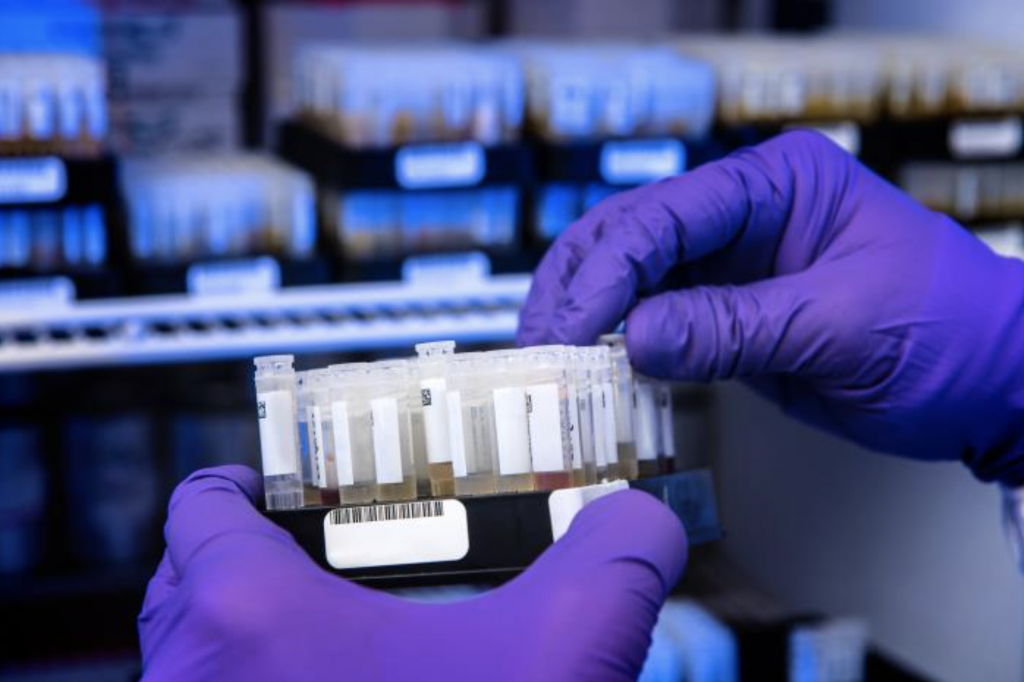Genomic Virus Data from State Lab to Help Shape Future Pandemic Response

A team of about a dozen microbiologists and other professionals has been on an important mission for more than a year: to collect and analyze data on the coronavirus to help epidemiologists determine how best to respond to the ongoing pandemic.
They’re part of a genomic surveillance project of the Hawai‘i Department of Health’s State Laboratories Division, led by Pamela O’Brien, who has been working in the lab for more than 16 years. The lab is tucked away on Waimano Ridge, above Pearl Harbor.
The team is immersed in lab investigations not only relating to coronavirus, but also involving foodborne illnesses, protecting Hawaiʻi’s food supply from Rat Lungworm and other diseases, addressing bioterrorism, and taking care of mosquito-borne illnesses such as Dengue Fever or outbreaks of the mumps and measles in geographical pockets where residents are not immunized.
The microbiologists have continued all of their usual responsibilities, while also working on pandemic-related priorities.
“In addition to confirming hundreds of COVID-19 infections each month, we’ve been taking a deeper look at the composition of the virus and variants,” O’Brien said.
The Centers for Disease Control and Prevention divides variants into three categories:
- “Variants of interest” are those that have specific characteristics that are associated with reduced effect of antibodies against infection and predicted increase in transmissibility or disease severity.
- “Variants of concern” have documented evidence of being more easily transmitted and can cause more severe disease leading to hospitalizations and death.
- “Variants of high consequence” are those with clear evidence that prevention measures or medical countermeasures have significantly reduced effectiveness in comparison to other variants.
The Hawai‘i State Laboratories Division is finding the majority of the COVID-19 cases in the state are the result of “variants of concern.” As of April 9, statewide, variants are found in nearly 70 percent of the specimens: 59 percent contain the B.1.429/B.1.427 variant (first detected in California), 8 percent have the B.1.1.7 variant (first detected in United Kingdom), and 2 percent have the B.1.351 variant (first detected in South Africa). On Maui, the B.1.429/B.1.427 variant (first detected in California) which is more easily transmitted, is found in more than 80 percent of the specimens, as of April 9.
In addition to conducting its own sequencing, the Hawai‘i State Laboratories Division also sends samples to the CDC for sequencing every two weeks. The Hawai‘i State Laboratories shares its genomic sequencing data with the GISAID, a global source of genomic data of viruses, originally established in 2008 as a Global Initiative on Sharing Avian Influenza Data. The data is used to prepare for the next stage of the pandemic response by helping to better understand the molecular epidemiology of SARS-CoV-2 and how the virus evolves. This influences diagnostic protocols and provides insights on future vaccine development.
Razvan Sultana, who joined the State Laboratories Division last year to fill the newly created position of bioinformatician, brings the worlds of biology and computer science together in his job. He holds a doctorate degree in bioinformatics from Boston University, and has a wealth of experience as a bioinformatics engineer and bioinformatician for cancer institutes in Boston and London and has worked at the University of Hawaiʻi’s John A. Burns School of Medicine for the past four years.
“Sequencing provides color to a black and white picture. We’re able to study new mutations and learn where they came from through their trail of ‘breadcrumbs.’ Biology used to look at a single gene just a few decades ago. Determining the whole sequence of a virus made of 30,000 letters used to be a tremendous feat. Today, for example, we look at all the 25,000 genes in the human DNA when we investigate what causes cancer, he said. “In the same way, we can determine all the letters in the SARS-Cov-2 virus, detecting changes from the original virus and allowing us to classify them as a specific variant. Doing this type of work requires a lot of computing power and complex algorithms.”
GISAID currently has more than 1.5 million virus sequences in its database and Hawai‘i has contributed 2,000 of those sequences. Diagnostic Laboratory Services, Clinical Laboratories of Hawai‘i, Kaiser Permanente, Synergy Medical Laboratories at the Daniel K. Inouye International Airport, and S&G Laboratories in Kailua-Kona on Hawai‘i Island share positive samples with the genomic surveillance project team. The State Laboratories Division also creates profiles from its own positive samples. The 2,000 profiles represent 5 percent of all the confirmed positive cases in the state, ranking Hawai‘i second only to Wyoming in terms of the highest percentage of cumulative cases sequenced.
The science behind virus mutation provides a compelling reason to be vaccinated. Some variants are more easily transmitted to others, and if someone is infected with the virus after being vaccinated, the symptoms of COVID-19 have been clinically shown to be not as severe. This reduces hospitalizations and relieves pressure on the state’s healthcare system.
“With our understanding of the way the virus evolves, the best way to stop the virus from spreading in our community is to get vaccinated. If the virus does not spread, it will not have the opportunity to mutate and create stronger variants that can endanger all of us,” Sultana said. “We have to break the cycle through vaccinations.”








